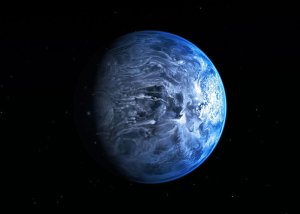

Anyone with a true fondness for space and astronomy will eventually stumble across Carl Sagan’s discussion of the Pale Blue Dot. This is a fond name that Sagan had for Earth which, given all of its water, looks a little blue. However, there is a true blue dot drifting out in the cosmos, and it’s not the Earth. It is HD 189733b, a cobalt-blue planet approximately 63 light-years from our solar system.
This planet reflects blue light a lot more than the Earth or the other planets in our solar system. So will we be able to make this planet into Earth 2.0? Not quite. In fact, saying that this planet is inhospitable is a bit like saying that the center of a volcano is inhospitable.
For starters, the planet is a scorching 2,000 degrees Fahrenheit (1,200 C). This is a bit problematic, as the highest temperature at which the human body can sustain life for any extended period is 108 degrees Fahrenheit/ 42 C (I feel the need to take a moment to recognize the magic number –42 –Douglas Adams, anyone? ). And even at this temperature, most people will die, especially those who already suffer from infirmity.
And this is only the beginning of the woes that HD 189733b has in store for us. In addition to the extreme temperatures, the planet rains glass. If that’s not enough, the amazing wind-speeds whip the glass about so that it rains sideways. In these howling winds, which reach 4,500mph (7,200kmh), you would literally be cut to pieces. For further comparison, an F5 tornado (the most intense tornado on Earth) has wind speeds that only reach 320 mph (420 kmh). These speeds are enough to debark trees, make automobile sized missiles fly through the air, level even the most well constructed houses and buildings, and cause your body to flap about like a rag doll, so you really wouldn’t stand a chance on HD 189733b.
So, what is it that makes this inhospitable planet blue? (at these extreme temperatures, it’s obviously not life-giving water)
Ultimately, the cobalt blue color comes from that planet’s hazy blow-torched atmosphere, which contains high clouds of silicate droplets. In essence, because of the extreme temperatures, the silicates form very small drops of glass that scatter blue light more than red light.
The key to this deadly planet lies in its proximity to its star. Ultimately, the planet is a mere 2.9 million miles from its parent star. For comparison, Mercury, the closest planet to the Sun, is a whopping 35.9 million miles (57.9 million km) from the solar surface.
TO SUMMARIZE:
